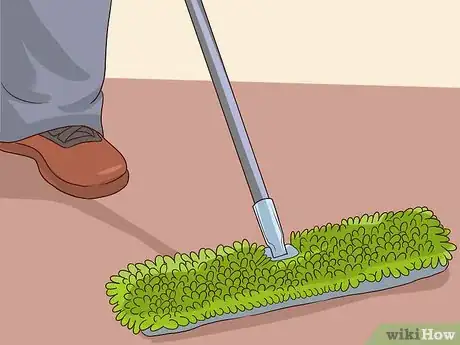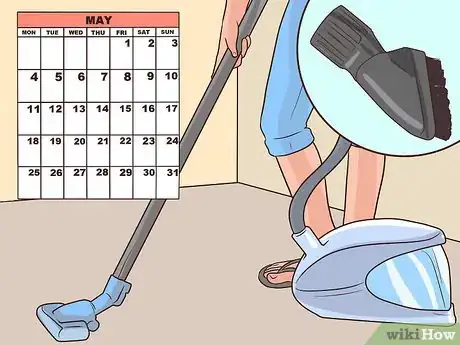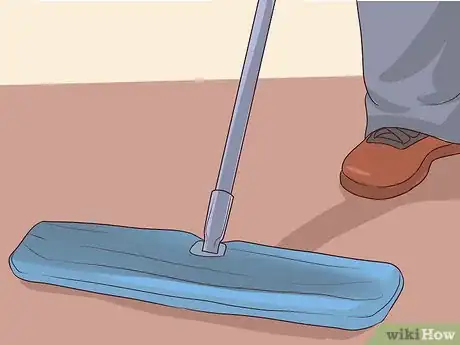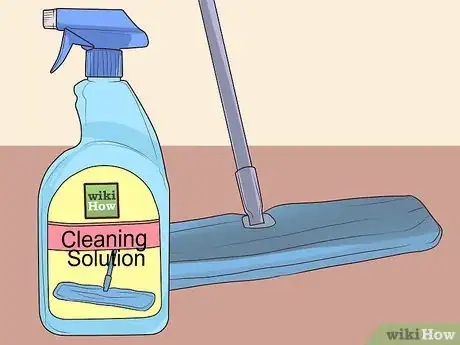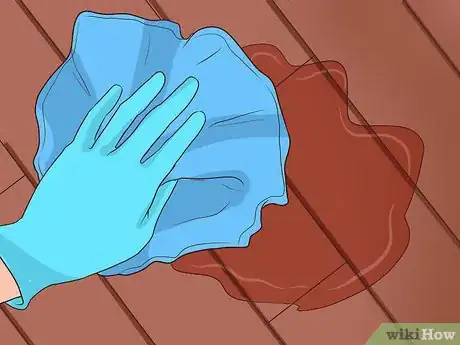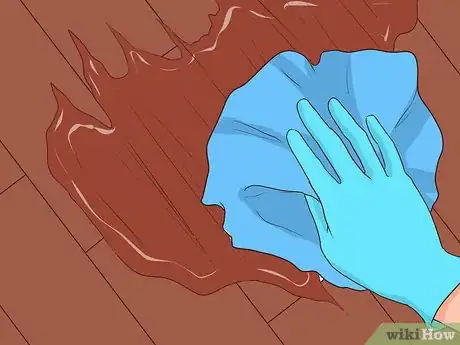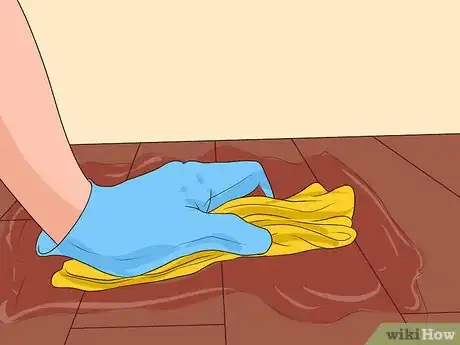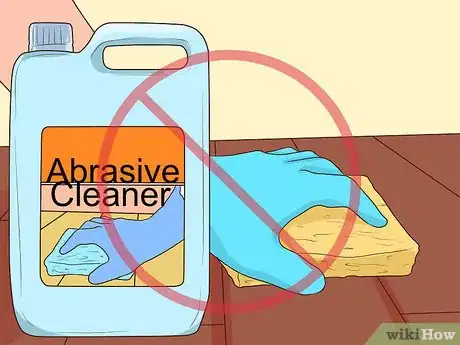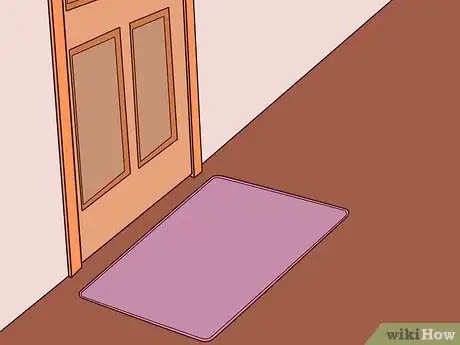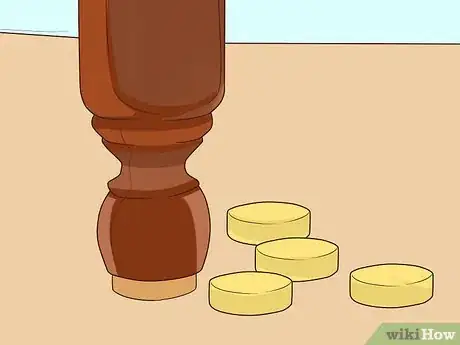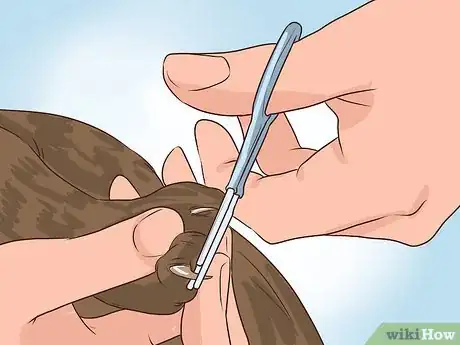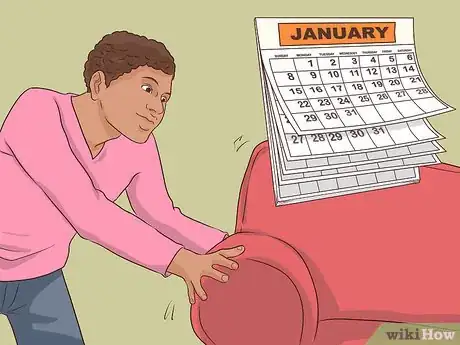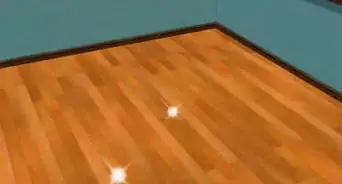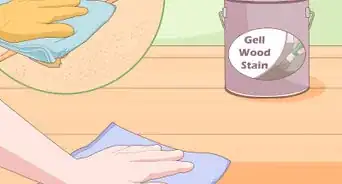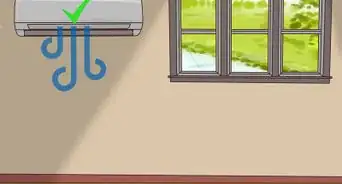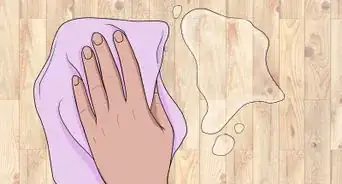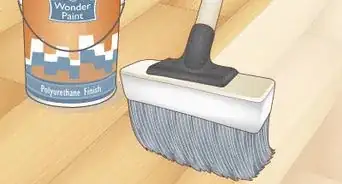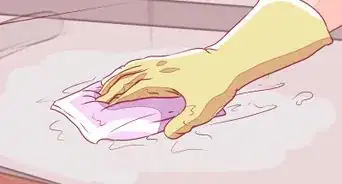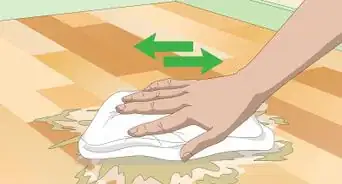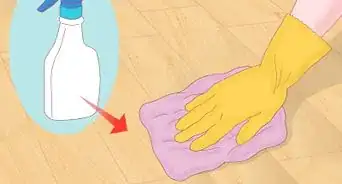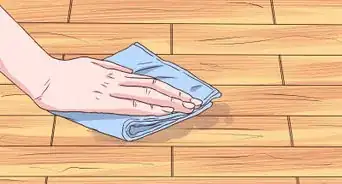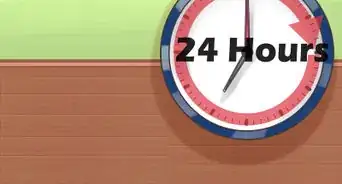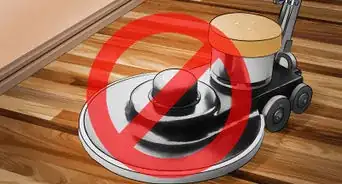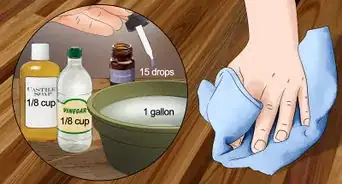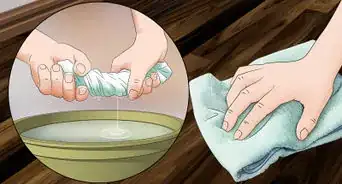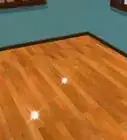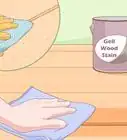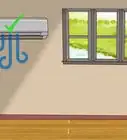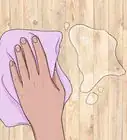This article was co-authored by Michelle Driscoll, MPH and by wikiHow staff writer, Amber Crain. Michelle Driscoll is the Owner of Mulberry Maids, which is based in Fort Collins, Colorado. With five years of experience, her business specializes in cleaning homes and small offices. She holds a Masters in Public Health from the Colorado School of Public Health. Additionally, Mulberry Maids has an A+ rating from the Better Business Bureau.
This article has been viewed 37,080 times.
Prefinished wooden flooring is a significant investment that you definitely want to protect. While cleaning isn’t difficult, there are a few rules that should be followed to keep your floor looking its best. Routine cleaning, such as dry dusting, vacuuming, and damp mopping, is your first line of defense. Spills should be addressed immediately and without excessive force to prevent surface damage from occurring. Using doormats can prevent a lot of issues and help you maintain your flooring for years to come.
Steps
Doing Routine Cleaning
-
1Dust the floors daily with a microfiber mop or cloth. Daily dry dusting will keep your prefinished flooring in peak condition. A mop with a microfiber mop head is probably the easiest tool to use for this. Since prefinished wooden flooring can be scratched by abrasive broom bristles, a microfiber mop is recommended over daily sweeping.[1]
- If you prefer to use a broom, make sure the bristles are extremely soft.
- A daily dusting should be sufficient for most areas. If you’re dealing with an extremely high traffic area, you may want to make an additional pass each day.[2]
-
2Vacuum weekly with a natural-bristled brush attachment. Even if you dry dust your floor every day with a microfiber mop, dirt and debris will eventually settle into nooks, crannies, and corners. Combat this with a weekly vacuuming session. Always use an attachment with natural bristles to prevent scratches and damage. Go over the entire floor, giving extra attention to nooks and crannies.[3]
- Avoid using upright vacuums with beater bars to prevent damage.[4]
Advertisement -
3Use a damp microfiber mop as needed. Mild dirt and grime can be cleaned up with a damp mop, no additional floor cleaner required. Wring the mop head out thoroughly and then run it over the floor to remove dirt and debris. After you damp mop, make sure there’s no standing water left on the floor. If you see any puddles, wipe them up immediately with a clean towel.
-
4Use a recommended cleaner and damp mop for stubborn dirt. For significant dirt, you may want to use a floor cleaner along with the damp mop. Your floor manufacturer will provide you with the most appropriate cleaners and products.[5] Follow your product’s instructions to create a cleaning solution, dunk your mop into it, and wring it out very thoroughly. Run it over the surface of the floor, focusing on the dirtiest areas and the corners.
- Prefinished hardwood flooring varies from manufacturer to manufacturer. A cleaner that works well on one surface may cause damage to another. Speak to your floor manufacturer about the best options for your floor.
- Avoid using products with ammonia and oil soaps on prefinished hardwood. These can be harmful to the wood finish and may leave behind residues that attract additional dust and dirt.
Addressing Stains
-
1Clean up spills as soon as they occur. The longer a spill is left on the floor, the deeper the resulting stain will be. Address spills as soon as possible after they happen. Use a clean cotton or microfiber cloth to dab at the spill gently. Don’t rub aggressively, because this can cause damage and embed the substance deeper into the floor. Keep dabbing until you’ve soaked up the spill.
- If the spill is sticky, use a lightly damp cloth to wipe it away. Dry the area with a microfiber cloth immediately.[6]
-
2Use a damp cloth on residual stains. If a spill has resulted in a stain, dampen a soft sponge or cotton cloth and wipe gently at the mark. If necessary, dampen the cloth very lightly with a floor cleaner recommended by the manufacturer and wipe at the stain. Do not use aggressive rubbing. This should remove the mark. Gently buff the area dry with a microfiber towel immediately afterward.[7]
- If you’re dealing with an oily or greasy stain, a floor cleaner with a high pH is recommended.
-
3Clean in the same direction as the wood grain to prevent water spots. Some prefinished flooring may show water spots, even if you’re using a very lightly dampened cloth on it. If you notice this on your floor, start cleaning in the same direction as the wood grain. This will help prevent water spots and also make any current ones less noticeable.[8]
-
4Avoid using anything abrasive on stains. The surface of your floor can be scratched easily by abrasive cleaners and sponges. Even aggressive rubbing with a soft cloth can cause damage and dull the surface of your flooring. Make sure you use gentle actions and tools when dealing with spills and stains.[9]
Maintaining Your Floors
-
1Protect the floor by using mats and rugs. Put down area rugs and door mats in high-traffic areas such as entrances and frequently used hallways. Make sure you put down good mats in front of entrance points from the outside, since dirt, water and debris tend to get tracked through these areas the most. [10]
- You may want to ask your family to remove their shoes at the door as an additional safeguard.
-
2Use felt floor protectors under chairs and furniture. Felt floor protectors can be purchased at home improvement stores and even some grocery stores. Simply remove the adhesive backing and stick the felt protectors under chair legs, couch legs and other furniture, especially the heavier pieces. Felt protectors can help prevent damage and scratching on the floor’s surface.[11]
-
3Trim your pet’s nails regularly. If your pet has nails or claws, they may scratch the surface of your floor and track in dirt. To prevent this, groom your pets frequently and keep their nails trimmed. Cut their nails so that the tips are blunted, with no sharp points.[12]
-
4Rearrange your furniture every few years. Over time, even well-maintained prefinished flooring will start to show signs of aging, such as dullness, fading and mild scratches. If you leave furniture and rugs in the same place for years at a time, your floor will age unevenly. Move your items around every year or so to prevent this.[13]
Expert Q&A
-
QuestionI have prefinished wood floors. No matter what I do after I clean it still shows a film and streaks. Do you have any suggestions?
 Michelle Driscoll, MPHMichelle Driscoll is the Owner of Mulberry Maids, which is based in Fort Collins, Colorado. With five years of experience, her business specializes in cleaning homes and small offices. She holds a Masters in Public Health from the Colorado School of Public Health. Additionally, Mulberry Maids has an A+ rating from the Better Business Bureau.
Michelle Driscoll, MPHMichelle Driscoll is the Owner of Mulberry Maids, which is based in Fort Collins, Colorado. With five years of experience, her business specializes in cleaning homes and small offices. She holds a Masters in Public Health from the Colorado School of Public Health. Additionally, Mulberry Maids has an A+ rating from the Better Business Bureau.
Founder, Mulberry Maids The film buildup and leftover streaks may be due to residue that cleaning solutions have left behind. One method to try and remove the residue is to use ammonia and warm water. Sweep and vacuum your floors first, then mix a 1/2 cup of ammonia in 1 gallon of warm water. Mop the floor, and then wipe and buff the floor with a microfiber cloth by hand. Note that you should not use ammonia for regular wood floor cleaning.
The film buildup and leftover streaks may be due to residue that cleaning solutions have left behind. One method to try and remove the residue is to use ammonia and warm water. Sweep and vacuum your floors first, then mix a 1/2 cup of ammonia in 1 gallon of warm water. Mop the floor, and then wipe and buff the floor with a microfiber cloth by hand. Note that you should not use ammonia for regular wood floor cleaning.
Things You’ll Need
- Microfiber mop
- Vacuum cleaner with a soft-bristled attachment
- Floor cleaner recommended by the manufacturer
- Towels
- Felt floor protectors
References
- ↑ https://na.pergo.com/how-to/floor-care-maintenance
- ↑ http://www.rovinsflooring.com/How-to-clean-pre-finished-hardwood-floors.html
- ↑ http://www.bruce.com/cleaning-hardwood-flooring.html
- ↑ https://www.angieslist.com/articles/what-s-best-way-clean-hardwood-flooring.htm
- ↑ http://www.rovinsflooring.com/How-to-clean-pre-finished-hardwood-floors.html
- ↑ https://www.woodmeister.com/caring-for-wood-floors
- ↑ http://www.rovinsflooring.com/How-to-clean-pre-finished-hardwood-floors.html
- ↑ https://www.woodmeister.com/caring-for-wood-floors
- ↑ https://www.woodmeister.com/caring-for-wood-floors
